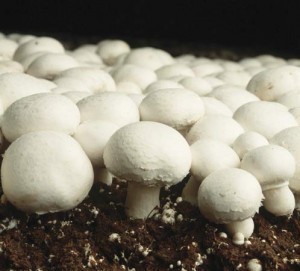COMMON NAME: The Button Mushroom. نام عمومی : قارچ دکمه ای

STRAINS: Type or Brown Variety (var. bisporus)واریته قهوه ای
White Variety (var. albidus)واریته سفید
Cream Variety (var. avellaneous) واریته کرم رنگ
GREEK ROOT: Agaricus comes from the greek word "agarikon" which scholars believed originated with a Scythian people called Agari who were well versed in the use of medicinal plants and employed a fungus called "agaricum", probably a polypore in the genus Fomes. The species epithet brunnescens comes from the latin "brunneus" or brown. Literally, the name means the fungus that becomes brown, probably referring to the color change of the flesh upon bruising. Also called Agaricus bisporus for the two spored basidia populating the gill faces.
ریشه یونانی: Agaricus از کلمه یونانی "agarikon"
GENERAL DESCRIPTION: A robust, thick fleshed Agaricus species, with thin gills that are pinkish when young, and darkening to sepia and then chocolate brown in age. The cap is characteristically brownish, whitish or cream colored. The cap surface is smooth to appressed squamulose and dry. This species has a short, thick stern which is adorned with a persistent membranous annulus from a well developed partial veil. Its spores are chocolate brown in mass.
توصیف خصوصیات عمومی:
NATURAL HABITAT: Naturally found in soils enriched with dung, on compost piles and in horse stables. A temperate species, widely distributed, A. brunnescens fruits from May until November over much of the northern hemisphere outside the tropical zone.
زیستگاه طبیعی:
GROWTH PARAMETERS پارامتر های رشدی
Mycelial Types: Moderately rhizomorphic; dingy white, sometimes with brownish hues.
Spawn Medium: Rye grain buffered with calcium carbonate and/or calcium sulfate. See Chapter III.
Fruiting Substrate: Nitrogen enriched wheat straw and/or horse manure based compost balanced to 71-74% moisture content. This species also fruits well on rye grain covered with an unsterilized peat based casing layer.
Method of Preparation: See Chapter V on compost preparation. Pasteurization achieved through exposure to live steam for 2 hours at 140 °F. throughout the substrate. Compost should be
filled to a depth of 6-12 inches.
Spawn Run: اسپان ران
Relative Humidify: 90-100%. رطوبت نسبی
Substrate Temperature دمای بستر : 76-78 °F. Thermal death limits have been established at 96 °F. but damage can occur as low as 90 °F.
Duration: 2 weeks. طول دوره اسپان ران
CO2: 5000-10,000 ppm. دی اکسید کربن
Fresh Air Exchanges: 0 per hour. تعویض هوای تازه
Type of Casing: After fully run, cover with the standard casing whose preparation is described in Chapter VIII. Layer to a depth of 1-2 inches. The casing should be balanced to a pH of 7.0-7.5.
Post Casing/Prepinning:
Relative Humidity: 90-100%.
Bed Temperature: 76-80 °F.
Duration of Case Run: 8-12 days.
CO2: 5000-10,000 ppm.
Fresh Air Exchanges: 0 per hour.
Primordia Formation:
Relative Humidify: 95-100%.
Compost Temperature: 65-70 °F.
Air Temperature: 62-65 °F.
CO2: less than 1000 ppm.
Fresh Air Exchanges: 4 per hour.
Light: None required.
Cropping:
Relative Humidify: 85-92%.
Air Temperature: 62-65 °F.
CO2- less than 1000 ppm.
Fresh Air Exchanges: 4 per hour.
Flushing Interval: 7-10 days.
Harvest Stage: Directly before the partial veil stretches.
Light: None required.
Yield Potential: Average commercial yields are 3 Ibs/sq.ft. over a 5 week cropping period. Maximum yield is 6 Ibs. per square foot.
Moisture Content of Mushrooms: 92% water; 8% dry matter.
Nutritional Content: 24-44% protein (dry weight); 56 milligrams of niacin per 100 grams dry weight.
Comments: Historically, this species and/or its close relatives were the first mushrooms to be cultivated in Europe during the late 1 700's. It remains the most widely cultivated mushroom in the world Today, A broad range of commercially available strains exist, many of which have been genetically selected for certain advantageous characteristics, especially yield, color and stature. This species does not form pinheads on agar media unless activated charcoal or select bacteria are present. A species sensitive to high levels of carbon dioxide, Agaricus brunnescens fruits only within narrow environmental parameters. As a secondary decomposer, this species fruits best on substrates that have been transformed by a succession of specific microorganisms. The common button mushroom is the mainstay of the mushroom growing industry in this country.
Genetic Characteristics: Basidia bipolar (2-spored), forming diploid spores; secondarily homothallic. The mating of compatible dikaryons typically results in strains both more vigorous and higher yielding. Clamp connections absent. See Chapter XV.
For further information consult:
P.J.C. Vedder 1978, "Modern Mushroom Crowing", Educaboek, Culemborg, Netherlands. (English edition available from Swiss American Spawn Company, Inc.. Madisonville, Texas).
Fred Atkins, 1973, "Mushroom Crowing Today", MacMillan Publishing Co., New York.
:: برچسبها:
Button Mushroom,
قارچ دکمه,
bisporus,
Agaricus
